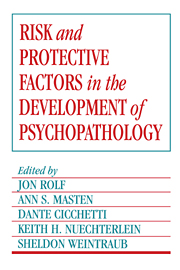Book contents
- Frontmatter
- Contents
- List of contributors
- Preface
- Part I Introduction: Historical and theoretical roots of developmental psychopathology
- Part II Contributions of the high-risk child paradigm: continuities and changes in adaptation during development
- 3 Early contributors to developmental risk
- 4 Beyond diathesis: toward an understanding of high-risk environments
- 5 Hard growing: children who survive
- 6 Children born at medical risk: factors affecting vulnerability and resilience
- 7 A mediational model for boys' depressed mood
- 8 A temperamental disposition to the state of uncertainty
- Part III Competence under adversity: individual and family differences in resilience
- Part IV The challenge of adolescence for developmental psychopathology
- Part V Factors in the development of schizophrenia and other severe psychopathology in late adolescence and adulthood
- A closing note: Reflections on the future
- Author index
- Subject index
4 - Beyond diathesis: toward an understanding of high-risk environments
Published online by Cambridge University Press: 06 August 2010
- Frontmatter
- Contents
- List of contributors
- Preface
- Part I Introduction: Historical and theoretical roots of developmental psychopathology
- Part II Contributions of the high-risk child paradigm: continuities and changes in adaptation during development
- 3 Early contributors to developmental risk
- 4 Beyond diathesis: toward an understanding of high-risk environments
- 5 Hard growing: children who survive
- 6 Children born at medical risk: factors affecting vulnerability and resilience
- 7 A mediational model for boys' depressed mood
- 8 A temperamental disposition to the state of uncertainty
- Part III Competence under adversity: individual and family differences in resilience
- Part IV The challenge of adolescence for developmental psychopathology
- Part V Factors in the development of schizophrenia and other severe psychopathology in late adolescence and adulthood
- A closing note: Reflections on the future
- Author index
- Subject index
Summary
During the formative years of the high-risk-for-schizophrenia movement, researchers devoted most of their attention to isolating early patterns of maladjustment and deviance among high-risk offspring. Their primary research agenda was to develop an understanding of those deficits, with an eye toward tracing them to later functioning and ultimately to diagnostic status. In more recent years there has been increased interest in and enthusiasm for examining protective factors: the environmental resources available to and the adaptive strengths characteristic of those high-risk children who do not show early signs of deviance. Whether this newer interest reflects a broadening of focus consistent with the seminal writings of Garmezy (1971, 1976, 1981, 1983) and others, or more accurately represents a displacement or misplacement of interest in factors responsible for early deviance, is a question with important implications for the future directions of high-risk research.
At the heart of this question is unsettling evidence throughout the high-risk literature of blurred distinctions between the concepts of risk, vulnerability, and maladjustment, and between risk reducers and protective factors. It is no less true in high-risk research than in other domains of inquiry that important answers often are obscured by the ways we frame our questions. And as we hope to demonstrate in this chapter, there is much to be gained through maintaining conceptual clarity in our thinking about and usage of these terms.
We begin by reviewing briefly the origins and current status of research concerning the etiology of schizophrenia and related disorders among the offspring of schizophrenic parents. Our goal is to highlight some of the methodological and conceptual issues that have shaped the nature and direction of this research.
Information
- Type
- Chapter
- Information
- Publisher: Cambridge University PressPrint publication year: 1990
Accessibility standard: Unknown
Why this information is here
This section outlines the accessibility features of this content - including support for screen readers, full keyboard navigation and high-contrast display options. This may not be relevant for you.Accessibility Information
- 42
- Cited by
